|
An article presented to American Digger magazine in July 2024
By Clifford Catania
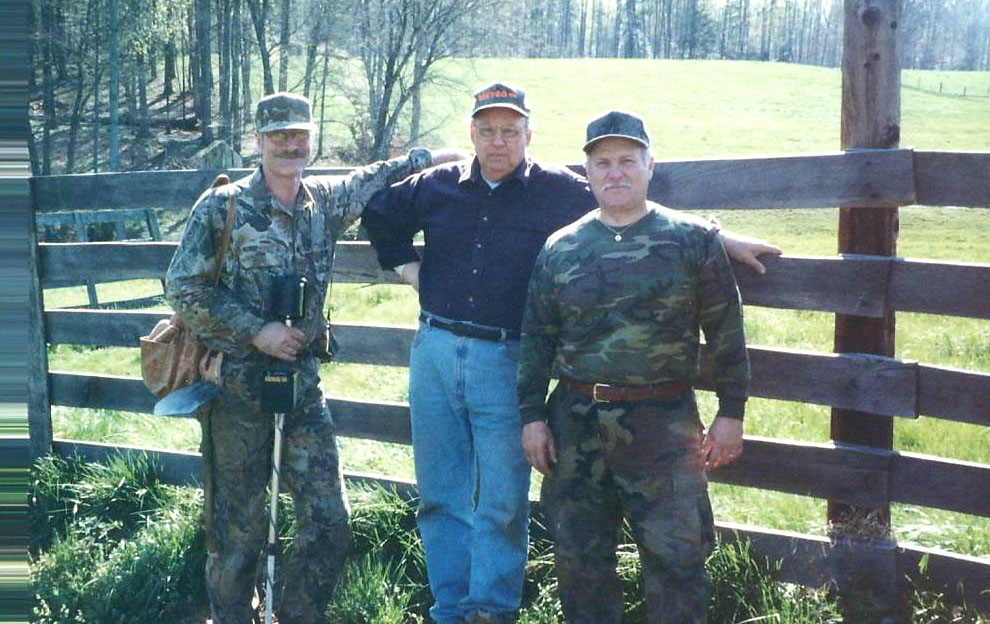
First Dig: Myself left, my mentor Ron Stonelake center, and another "newbie".
Collectors and Collecting, these are topics which reach just about everywhere in our lives as relic hunters. The issues and deep rewards of searching for Civil War artifacts are clear to those enthusiasts and adventurers who read the American Digger. We seem to all be wired the same way inside our imaginations. So, yeah, we run on the same type of electricity.
Basically, you aren't a collector unless your passion is stirred as thoroughly as your intellect. A museum curator giving a cool, calculated lecture on the dozens of Civil War weapons stacked in the basement is not a collector. But the Average Joe who sits and gazes at a badly pitted Colt revolver wondering who used it and how exactly it was lost is definitely an enthusiast. This true admirer of battle relics might just wake up late one night and sneak down to his man cave in order to hold that old, rusted weapon. A museum administer never goes and sits with his acquisitions at night. So it's really all about whether you have that burning passion or not.
Of course, there are many other elements to being a collector, hobbyist, or "specialist" in anything. By tempering our passions with real knowledge, we can focus our enthusiasm in clear, concise directions. We can do a lot: investigate, assemble, learn and even teach. Besides just learning what is already known, we can add to it with our discoveries. And that's good because while all the technical facts are always stored in those "official" record books somewhere, the human story of the past is mostly kept alive in the minds of those awesome people called "buffs." We clearly see this fact played out by the Civil War reenactors who give immense amounts of their time and energy to honoring our ancestors in a real and open sense. They embody that "common thread" which links all of us who cherish the story of the American Civil War. That unifying thread is our imaginations, that ability of some people to dream of what's not right before their eyes in order to feel something communicating from somewhere else. We need that ability: to reach beyond those little two seconds in which we currently exist. It yields a deeper degree of understanding. And you can't really study or collect Civil War without empathy within your heart.
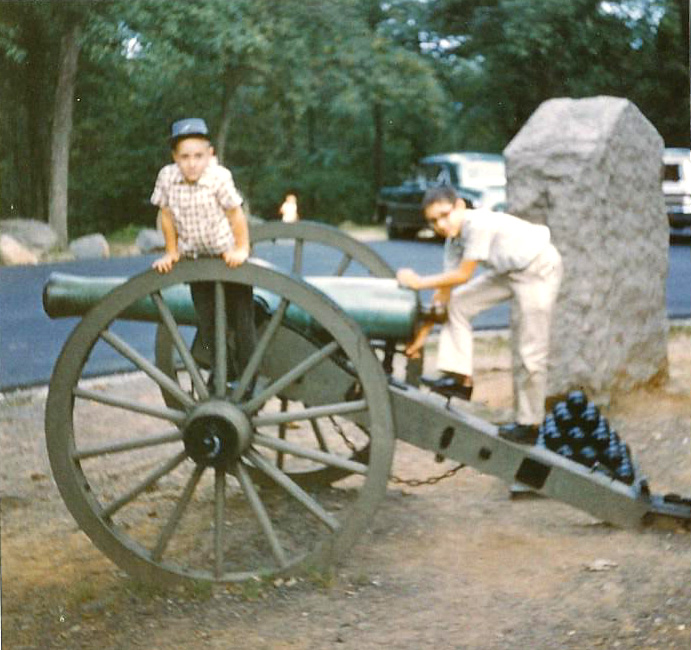
Me and older brother Matt at Gettysburg 1963 Centennial. |
The entire process of collecting Civil War relics is like a vast meal of many courses for the soul. We come to understand a bit more about faith, loyalty, courage and even love as very real things rather than simply ideas on TV or a cell phone screen. As enthusiasts, we come to learn discipline in order to focus upon cherished values of humanity. So, in a way, we become married to this thing which we admire. We are no longer alone in the world like some free-floating pieces of life. Rather, the true collector suddenly begins to share ideas and values with an entire community of similarly inspired individuals. We become a close-knit famity, linked by the past, present and even the future.
In any case, we each know where we came from and how we first became inspired. Our reasons for collecting Civil War items are just as important as the stories of our relics themselves. They are deeply intertwined. And that is why I love to listen to the tales told by diggers young and old. Our individual doorways into the hobby are diverse: Led in by family, army buddies, coworkers, the guy next store, a docent, shop owner, grumpy old recluse on a farm or even dear old Dad. But no matter our paths, we all ended up here in the same great club, excited beyond reckoning with artifacts from the greatest conflict fought on American soil. My own journey was glorious. I was a baby chick born into a raucous nest of military history fanatics. My good old Dad took his brood to the 1963 Centennial at Gettysburg in a big station wagon with fins. I still have the photographs of my older brother and I playing on green patina cannons. The handful of Union three-ring minies that my father purchased for me at a ramshackle cabin for twenty-five cents each still reside in a shadow box over my desk. Yup, anyone can become a fanatic when fed on an early diet of history like that. Essentially, my family cast me out into this curious universe the same as when one puts a message into a bottle and sends it out to sea. It was only a matter of time before I'd be back.
Important things in life never go away. They hover in the back of our minds like a mental DNA waiting to be resurrected. So, in 1998, when I was a single dad trying to entertain two kids on weekends, Grandpa came to visit us in Pennsylvania. We took him to Skippack, a quaint tourist town full of small shops and places to feed your relatives. In the midst of browsing through bric-a-brac and children's toys, we spied a small cabin set back off the main drag. A small wooden sign read: "The Limber Chest, Civil War Relics." From its peeling paint, one might expect to find Lil' Abner inside wearing a bad rebel uniform. But rather, within that musty one room shop, I met my true Civil War mentor, the large, amiable Ron Stonelake. This bear of a man immediately made everyone feel safe and valued as if you were his very own kin. As I gawked at walls and cabinets chock full of amazing treasures, my Dad and the friendly owner chatted like two old pals from the good ole days. My two collecting mentors had met. I was now in my personal Nirvana.
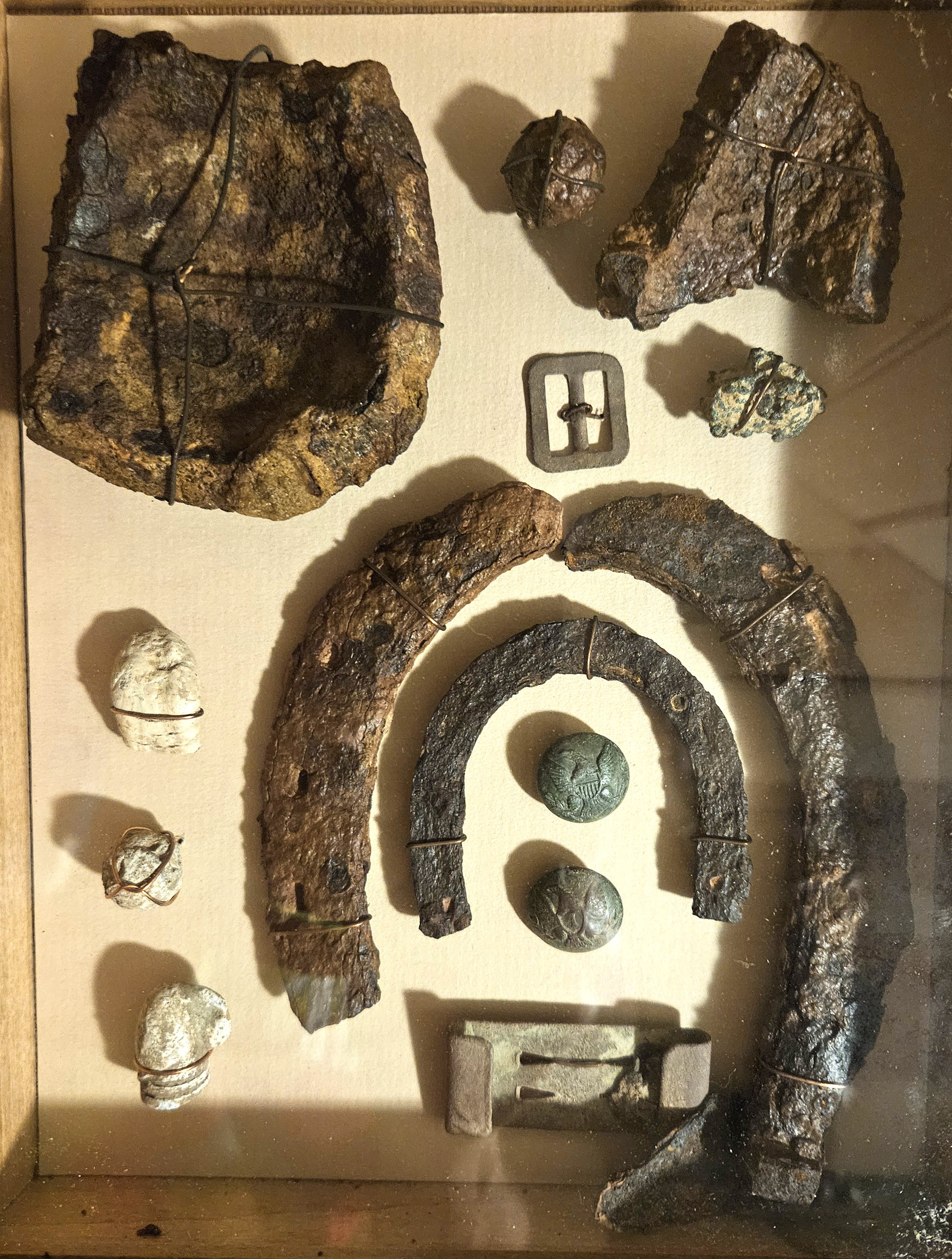
My first dug relics from Mine Run, VA now in a shadowbox. |
Soon, I was visiting that little shop of treasures at least once a week. Much of the inventory had been discovered by Ron during his decades of metal detecting mostly in Virginia. He'd come to develop warm friendships of deep trust with many farmers who owned tracts of land on major Civil War battlefields. And even when those property owners went to that Big Supply Depot in the Sky, their children uniformly would only allow Mister Stonelake to hunt their land. One cardinal rule of our hobby is that loyalty is king.
Well, I suppose that every time Ron talked about his spectacular early recoveries, I looked like a hungry hound dog sad for a bone of my own. Soon, my kind teacher took pity upon me. (Or maybe he was just tired of seeing me holding a credit card instead of a shovel?) One day he suddenly announced, "How's about I take you digging, Son? How'd you like to go with me to Virginia? We can hunt some of my secret spots." Well, this was the equivalent of Racquel Welch asking a thirteen-year-old boy in the Sixties if he wanted to see her in a bikini. I yelped like a happy puppy!
Two weeks later, Ron gathered three "newbies" including myself into his huge SUV and headed South. His extra metal detectors rattled in the back against shovels and beer cans. I was like a wide-eyed toddler gazing out the window at Disney as the rolling hills of Virginia farmlands appeared. No Mickey, just relics! These were the same green acres where cannon had howled and musketry crackled about 135 years prior. Now it was just crickets and cows chewing cud. Ron quickly taught us how to run the detectors, recognize the tones, dig a proper plug and to show some adult restraint at resisting dramatic Happy Dances. We learned not only the techniques but also the etiquette of metal detecting. More importantly, after days out in the baking sun and cooler evenings at the Cracker Barrel, we'd come to understand about the true brotherhood of relic hunting. In a way, we weren't much different than those hundred young men from the same small village who fought side-by-side in this same area over a hundred years before. The camaraderie experienced by both soldiers and artifact enthusiasts is similar.
Ron first took us out along the Mine Run Creek where a sizable skirmish had occurred in late 1863 between the Blue and Gray. We hunted a rolling hill which faced the creek where the Union forces tested the Confederates. Swinging the detector for the first time was like a baby taking careful steps. My first Civil War relic was a Federal "Eagle I" cuff button. It might as well have been the Hope Diamond. I was awed. I rubbed it clean with my thumb, read the faint backmark and immediately drifted into a spurt of runaway imagination. Who'd worn it? How exactly was it lost? Did the young soldier survive to see the war end? Thoughts like this are what keeps me glued to the cases in museums all day long while the rest of the group leaves to go get themselves an Italian water ice. Next, another newbie found a rusty musket wrench. Ron dug an amazing Alabama AVC button with tons of gilt. By day's end, I was over the moon with my booty found at Mine Run: five Union minies, three cannonball frags, two horseshoes, six eagle buttons and a belt adjuster. I no longer had that look of desperate hunger on my face. Instead, I wore the expression of a fan whose team had just won the Superbowl. I'd been initiated into the "Been There, Done That" Brotherhood.
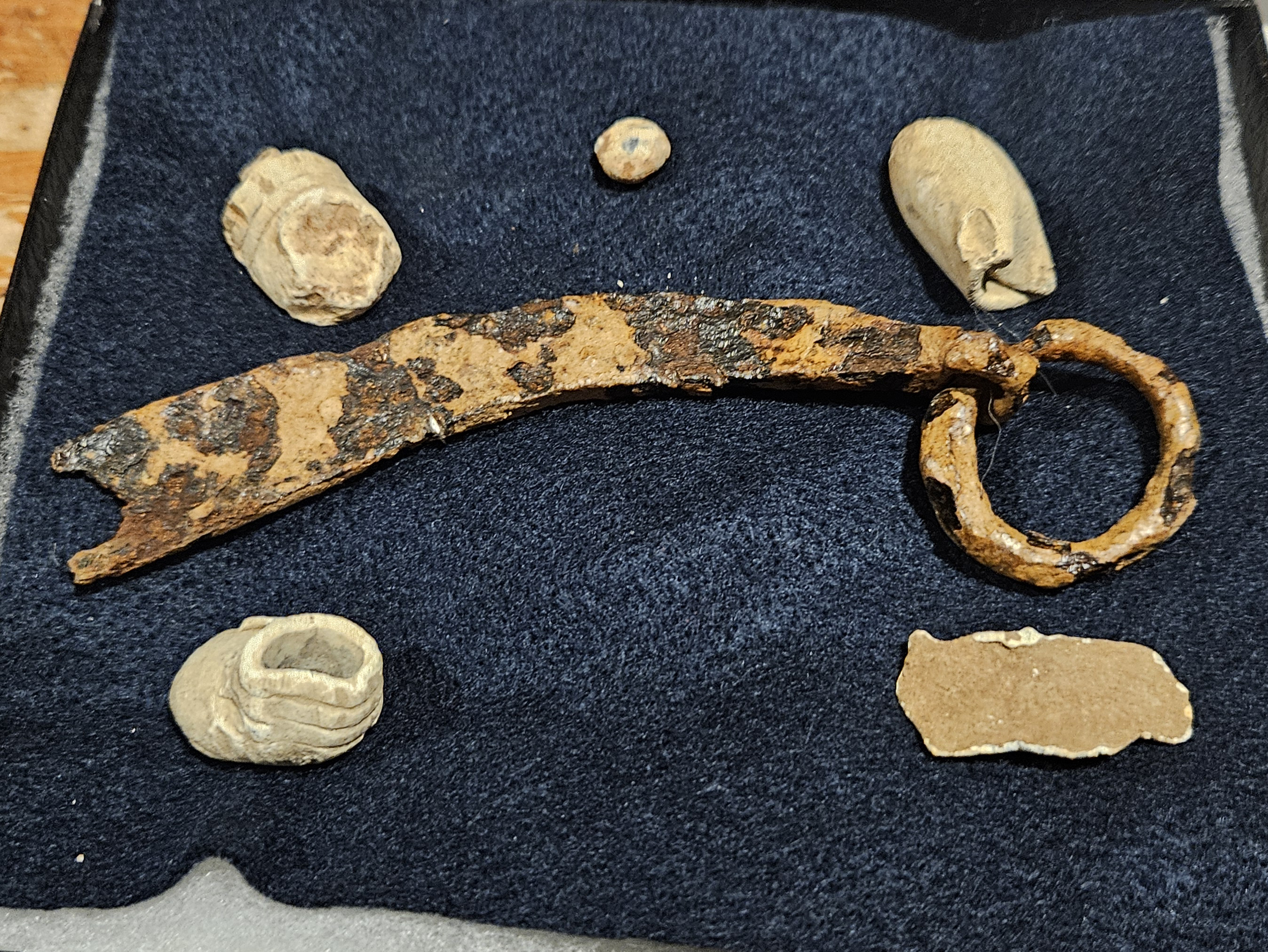
More first dig relics from Ronís secret spot in Chancellorsville. |
Our next destination was a farm in the center of the Chancellorsville battlefield. For decades, it had been Ron's sole dominion. Reaching the broad field, our jovial leader taunted in a playful fashion. "When I first set foot here, it was loaded with plates, bayonets and buttons about four inches deep. And, oh yeah, a few guns too." He watched our faces drop as if the last piece of pizza was already gone. But then he quickly proclaimed the Golden Rule, "But there is always something still out there." Indeed, I recovered eight dropped 69 caliber minies from under a little shade tree. Likely a nervous lad had dropped most of his ammunition from his trembling hands. "Imagine getting hit by that!" Ron quipped over my shoulder. "Nastier than a bill from the IRS." Later, Ron suggested that I walk along a small creek in order to detect the mossy bottom. "Why?" I asked in confusion. "Well, bullets can land in creeks the same as dry ground," he informed. "And you have a good chance of finding some because I was never stupid enough to get my boots soaked by walking down in there." He belly laughed and left me to my water sports. I discovered about fifteen three-ringers snuggled underwater in the rocks. They hang in a shadow box over my head at this very minute. And I can still hear Ron's laughter as I gaze at them. Overall, that long weekend was fabulous. Not just for my bag of Civil War goodies, but also for those deep bonds which we all formed.
The process of actually raising war relics from their graves served to verify my belief that historic artifacts should not be left to decay underground. They should be brought back out into the light in order to proclaim their messages. We needed to resurrect them for the enrichment of future generations who would benefit from their stories. Holding an actual relic in your hands is more visceral and inspiring than reading a screen of text from a Google search.
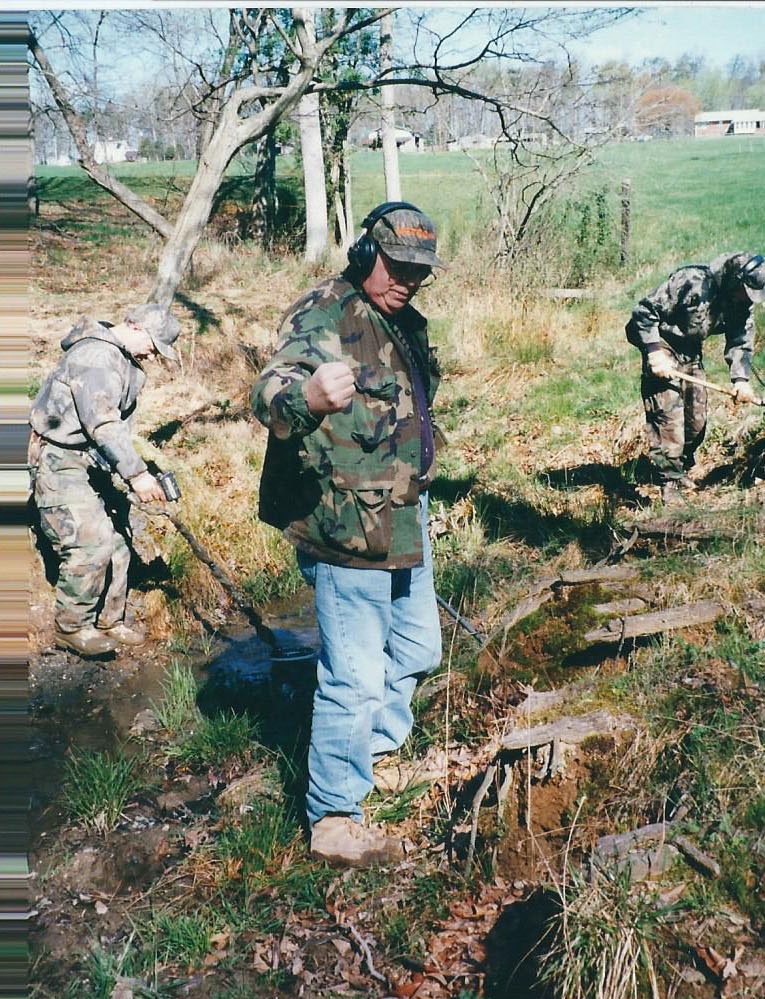
Ron teaches his flock of beginners to: Look, Listen and...Pray! |
So, why do we hunt and collect? It must be something simmering down deep in curious people. It's that pilot light which ignites our fossil fuels. But in addition to the jubilation felt, some wise cautions are in order. True collecting is not about the monetary value of what we acquire. Rather, it's the historical story which equates to its real value. Therefore, never make your collecting of Civil War artifacts about money. Never sell out to superficial greed. As dedicated enthusiasts, our goals should be to feed our imagination and curiosity rather than our bank accounts. We need to pay homage, not the electric bills. In the end, as a purist, your personal rewards will far exceed your initial expectations. Personally, I have been blessed to meet some of my very best friends through my Civil War endeavors. In fact, I even named one of my buddy's children who is now a sixteen-year-old in Amsterdam left wondering where the heck she got her unusual name. In a way, relic hunting retools your heart as well as your mind.
Yes, artifacts do seem to have their own messages or "inner voices" because they speak directly to the imagination of their viewers. They whisper their tales to us, paying homage to the sacrifices of young warriors long gone. They keep whispering till you agree to hear and consider their entreaties. (Author disclaimer: I have never actually heard or talked to a relic. So, I still am off the TSA watchlist.) But to be honest, my little batch of minies and rusted horseshoes is of more value to me than all the rare relics in all of the Civil War museums combined. I gave them birth from the red clay of Virginia. They are my children. They carry those little notes back in bottles from my past.
And so, in conclusion, each of you has found your own individual way here. We stand in the same place as members of that one big club that will forever honor the facts and figures of the Civil War. The challenge is to stay focused. Don't exist to collect. For that would steal too much from the rest of your lives. Rather, simply stay dedicated, curious and evenly balanced. Remember that behind all the objects in your collection lies the story of actual men and women who once struggled for a powerful cause. Sure, sure, we've got to preserve their weapons and uniforms. But honestly, these external things were not them. Rather, it was their spirits and souls which we should work to respect and emulate. Simply put, we must bring their personal stories and struggles to the surface as much as their possessions. For the real tools and weapons of any army is in its character and motivations. Having preserved their epitaphs, none of these noble warriors can be lost to time. They live within our minds. And for all of our efforts, we might win something for ourselves as well. We become more sensitive to a greater, deeper humanity within. We are not left wandering aimless or alone. We join one big family of similarly minded people, many of whom are now reading this magazine. I had my Ron, my family, my dear collector friends. And through these deep associations, the chain of faith and honor leading back to the brave warriors of the American Civil War will forever be preserved.
Here's to your good fortune in all of your journeys!

If you donít mind wet boots, then hunt the creek...Before I do! |
| | 
Still too curious for my own good?
|